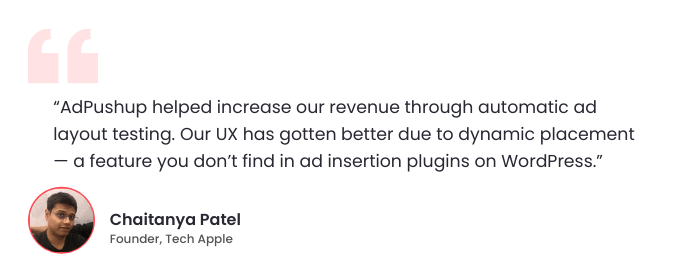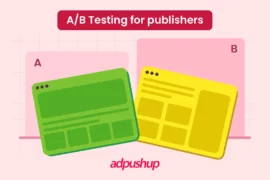Ad tech loves its three-letter acronyms, and one of the most commonly heard ones is SSP, short for supply side platform. So, what are supply-side platforms? Who uses them? And how do they work? Here’s everything you need to know.
As a publisher, your primary goal is to maximize revenue while delivering relevant and engaging content to your audience. That’s where SSPs come into play. These platforms act as intermediaries, connecting you with a vast network of advertisers vying to display their ads on your website. And in fact, SSPs are increasingly becoming popular. According to a survey by Statista, it was found that U.S. publishers in the second half of 2021, used an average of 5.4 supply-side platforms (SSPs).
In this comprehensive guide, we’ll dive deep into the workings of SSPs, exploring their functionalities, benefits, and the immense value they bring to your business. By harnessing the power of programmatic advertising, SSPs empower you to efficiently manage and monetize your ad inventory, ultimately leading to increased revenue streams.
Now without further ado, let’s dive right into the heart of the matter.
What is a Supply-Side Platform?
A supply-side platform (SSP), also known as a sell-side platform, is a technology platform that enables web publishers to manage their ad inventory, fill it with ads, and receive ad revenue. That’s pretty much it. However, we cannot explain what is a supply side platform without touching base on what a demand side platform is.
So, let’s try to understand what is a demand side platform.
What’s a Demand-Side Platform?
We’ll cover that in more detail in another post but for now let’s just say that while SSPs are used by publishers to sell ad space, DSPs (Demand Side Platforms) are used by advertisers to buy ad space.
The main function of a DSP is to help advertisers buy ad impressions from ad exchanges as cheaply and efficiently as possible, while the main function of an SSP is to help publishers maximize ad revenue. Both platforms run on similar technologies but are used at different ends of the transaction.
How Does a Supply Side Platform Work?
A supply side platform opens up the publisher’s ad inventory to multiple ad networks, ad exchanges, and DSPs simultaneously. This allows a huge number of potential buyers to bid and purchase ad space on a publisher’s website. This increases the bid competition and enables publishers to get the highest possible rates for their ad impressions.
The underlying principle is the economics of supply and demand, by increasing the demand pool for a publisher’s ad inventory, SSPs increase the value of the publisher’s ad inventory. For this reason, SSPs are also sometimes called “yield-optimization platforms”.

How do SSPs fit into the programmatic advertising ecosystem?
In the world of programmatic advertising, where ad space is bought and sold automatically, Supply-Side Platforms (SSPs) champion the cause of publishers. Imagine them as tireless salespeople working tirelessly to fill a publisher’s website or app with ads.
Here’s how SSPs bring value to publishers:
Wider Audience, More Revenue
SSPs connect publishers to a vast network of ad exchanges, demand-side platforms (DSPs), and ad networks. This opens the door to a massive pool of potential advertisers, significantly increasing the chance of filling ad space and boosting revenue. Additionally, SSPs automate the process of selling ad inventory. Publishers set their criteria like pricing and targeting options, and the SSP handles the technical aspects, freeing up valuable time and resources.
Tech-Savvy Revenue Optimization:
Many SSPs are equipped with yield optimization features. These leverage data and user behavior to determine the optimal price for each ad impression. Think of it as having a pricing expert constantly on hand, ensuring publishers get the most out of their ad space.
Real-Time Bidding Arena:
SSPs are central players in Real-Time Bidding (RTB), a core element of programmatic advertising. When a user visits a publisher’s website, the SSP initiates an auction. It sends out an ad request with details about the available ad space and the website’s audience. Advertisers competing through DSPs then bid on the opportunity to display their ad.
Transparency & Control:
The SSP acts as an auctioneer, evaluating bids based on factors like price, advertiser quality, and targeting criteria. It then selects the winning bid and delivers the corresponding ad to the publisher’s website. Additionally, SSPs provide publishers with valuable tools and reports to monitor the performance of their ad campaigns. This allows publishers to track revenue, analyze audience demographics, and identify areas for improvement.
By streamlining ad sales, connecting to a wider pool of advertisers, facilitating real-time bidding, and offering valuable insights, SSPs are key partners for publishers navigating the complexities of programmatic advertising.
What are the main components of an SSP?
Here are the main components of a Supply-Side Platform (SSP):
Ad Exchange Integration:
An SSP connects publishers to a network of ad exchanges. These exchanges act as marketplaces where advertisers (through DSPs) and publishers (through SSPs) can connect to buy and sell ad inventory.
Inventory Management:
The SSP allows publishers to manage their ad inventory efficiently. This includes defining available ad space (zones and slots), setting pricing models (cost-per-thousand impressions, cost-per-click), and targeting options (demographics, interests).
Yield Optimization:
Many SSPs offer yield optimization tools that use data and analytics to maximize revenue from ad inventory. This can involve techniques like:
Real-time bidding (RTB) management:
The SSP automatically manages RTB auctions, ensuring publishers get the best possible price for their ad space.
Demand forecasting:
The SSP analyzes data to predict future demand for ad space, allowing publishers to adjust pricing strategies accordingly.
Ad format optimization:
The SSP can recommend the most suitable ad formats (banner ads, video ads) for different ad placements to maximize revenue.
Analytics and Reporting:
SSPs provide publishers with comprehensive reports and analytics about their ad campaigns. This data can include impressions served, clicks generated, revenue earned, and audience demographics. Publishers can leverage this information to gain insights into campaign performance and optimize their strategies.
Integrations:
Modern SSPs offer integrations with other ad tech platforms such as Data Management Platforms (DMPs) and ad servers. DMPs provide audience data that can be used for more targeted advertising, while ad servers handle the actual delivery of ads to publisher websites and apps.
User Interface (UI):
The SSP provides a user-friendly interface for publishers to manage their ad inventory, set campaign parameters, and access reports and analytics.
What Are the Main Features of an SSP?
SSPS has multiple features that make the publisher experience easier and less cumbersome. Here are the main features of a Supply-Side Platform (SSP) that need to be analyzed:
Exchange Connectivity:
An SSP acts as a bridge between publishers and the programmatic advertising world. It integrates with various ad exchanges, creating a single platform for publishers to access a vast network of potential advertisers. This eliminates the need for publishers to manage individual relationships with each ad network or exchange.
Inventory Management:
An SSP empowers publishers to effectively manage their ad inventory. Publishers can define their available ad space by creating zones and slots, specifying their characteristics (size, location). They can also set pricing models (CPM – cost per thousand impressions, CPC – cost per click) and target audience demographics or interests for each placement. This ensures control over how their ad space is used and monetized.
Yield Optimization:
Many SSPs go beyond simple inventory management by offering yield optimization features. These leverage data and analytics to maximize a publisher’s revenue from ad inventory.
RTB Management:
The SSP automates real-time bidding (RTB) auctions, ensuring publishers get the most competitive bids for their ad space.
Demand Forecasting:
By analyzing data, the SSP can predict future demand for specific ad placements, allowing publishers to adjust pricing strategies to capitalize on peak periods.
Ad Format Optimization:
The SSP can recommend the most suitable ad formats (display ads, video ads) for different placements, considering factors like user behavior and potential revenue per format.
Analytics and Reporting:
SSPs provide publishers with in-depth reports and analytics on their ad campaigns. This data includes impressions served, clicks generated, revenue earned, and audience demographics of those who viewed the ads. These insights allow publishers to understand campaign performance, identify areas for improvement, and optimize their strategies for better results.
Integrations:
Modern SSPs integrate with other ad tech platforms to create a more comprehensive advertising ecosystem. For instance, Data Management Platforms (DMPs) can be integrated to provide audience data for more targeted advertising. Additionally, ad server integrations ensure seamless delivery of ads to publisher websites and apps.
User Interface (UI):
A user-friendly interface is crucial for publishers to interact with the SSP effectively. It allows them to manage ad inventory, set campaign parameters, access reports and analytics, and monitor the overall performance of their ad space monetization efforts.
Supply Side Platform Vs. Demand Side Platform
|
SSP (Supply Side Platform) |
DSP (Demand Side Platform) |
|
|
Purpose |
Maximize revenue for publishers |
Help advertisers reach audiences |
|
Control |
Publishers have inventory control |
Advertisers have bidding control |
|
Target Audience |
Publishers, media companies |
Advertisers, marketing agencies |
|
Ad Placement |
Optimize ad placement on websites |
Target specific audience segments |
|
Auction Type |
First-price auction model or header bidding |
Second-price auction model or RTB |
|
Data Usage |
Utilize publisher data for targeting |
Utilize user and third-party data |
|
Relationship |
Connect with DSPs to sell inventory |
Connect with SSPs to buy inventory |
|
Goal |
Increase revenue and ad performance |
Achieve efficient ad campaigns |
Now that you are well-versed with the differences SSPs and DSPs share with each other, let’s understand how a supply side platform works.
What are The Benefits of Using an SSP?
Let’s now have a look at the wide array of benefits a supply side platform has to offer.
Ad Revenue Optimization
An SSP in advertising world connects publishers with a diverse pool of advertisers, fostering increased competition and driving up ad prices. It comes with a wide array of features, including real time bidding, advanced targeting, and more.
Real-time bidding and advanced targeting capabilities result in improved ad performance and higher click-through rates. Additionally, detailed analytics offer valuable insights to optimize ad strategies and maximize revenue potential.
Automated Ad Buying
Implementing a Supply Side Platform (SSP) allows publishers to automate the ad buying process, streamlining operations and saving time. With automated ad buying, publishers can focus on creating valuable content while the SSP handles the complexities of ad transactions, ensuring a seamless and efficient advertising experience.
Improved Efficiency
A supply side platform can enhance operational efficiency by centralizing ad management tasks. Publishers can access all their ad inventory and performance data in one place, making it easier to monitor and optimize campaigns. This efficiency leads to better resource allocation and increased productivity in managing advertising operations.
Enhanced Targeting Capabilities
Next, by leveraging data-driven insights, a supply side platform enable publishers to target specific audiences with precision. Advanced targeting capabilities ensure that ads reach the most relevant users, increasing the likelihood of engagement and conversion. This targeted approach results in higher ad performance and a more satisfactory user experience.
Access to Diverse Demand Sources
SSPs provide publishers with access to a diverse range of demand sources, including various ad exchanges and demand-side platforms. This wide network of advertisers expands revenue opportunities and reduces the risk of relying on a single source of demand, ensuring a stable and robust advertising ecosystem.
Ad Quality Control
Another benefits of using a supply side platform is having a control over the quality of ads. SSPs offer ad quality control tools to safeguard publishers from displaying low-quality or irrelevant ads. With the ability to set specific criteria and guidelines, publishers can ensure that their brand integrity is upheld, and users are presented with high-quality, relevant or contextual advertisements.
Monetization of Unsold Inventory
Lastly, through programmatic ad selling, SSPs enable publishers to monetize their unsold ad inventory. Rather than leaving ad spaces vacant, SSPs connect publishers with relevant ads from various sources, maximizing revenue potential and minimizing wasted opportunities.
Now you must be wondering who controls the ad inventory, so let’s have a look.
Granular Reporting
Forget basic metrics like total impressions. Granular reporting hands you a magnifying glass to scrutinize your ad performance in minute detail. Analyze everything from device breakdowns (desktop versus mobile) to user location, ad format effectiveness, and even the performance of individual ad placements within your website or app.
This data empowers you, the publisher. Identify weaknesses, optimize strategies based on hard facts, and ultimately squeeze every drop of revenue from your ad space. Granular reports expose underperforming ad formats on mobile. You can adjust your approach to prioritize formats that resonate better with mobile users. By wielding the power of granular reporting, you take control and make data-driven decisions to ensure your ad space flourishes in the ever-changing world of programmatic advertising.
Dynamic Price Floor
Dynamic price floor use real-time data to automatically adjust the minimum acceptable bid for your ad space. Imagine factors like device type, user location, and even the day of the week influencing your ad rates. This data-driven approach can lead to increased revenue, reduced unsold inventory, and more efficient ad management, although it does require integration with an ad server or SSP and some fine-tuning to find the optimal balance for your specific needs. So, ditch the static approach and embrace the dynamic future of ad pricing!
Aggregation of Multiple Networks
The aggregation of multiple ad networks within an SSP streamlines the process of selling digital advertising inventory for publishers. By integrating with various ad networks, SSPs provide publishers access to a diverse range of advertisers and demand sources, increasing competition and driving up ad prices. This enables publishers to maximize their revenue potential by ensuring that more of their ad inventory gets sold at competitive rates. Additionally, SSPs employ sophisticated algorithms to dynamically allocate ad impressions to the highest bidding advertisers in real-time auctions, further optimizing revenue generation for publishers.
Supply Side Platform vs. Ad Exchange
In the programmatic advertising world, two key players work together: Supply-Side Platforms (SSPs) and Ad Exchanges. Imagine SSPs as tireless salespeople for publishers. They manage publishers’ ad inventory (website or app space), connect them to a vast network of potential advertisers, and even offer features to maximize revenue from that space. This could involve setting optimal prices or using data to predict future demand. Publishers can also monitor their ad performance through reports and analytics provided by the SSP.
Ad Exchanges, on the other hand, function as a neutral marketplace. Here, the buying side (advertisers through Demand-Side Platforms or DSPs) meets the selling side (publishers through SSPs). Ad Exchanges handle the core function of programmatic advertising: Real-Time Bidding (RTB) auctions. When someone visits a publisher’s website, the SSP sends an ad request to the Ad Exchange. Advertisers then compete through DSPs, with the highest bidder winning the right to display their ad. This efficient and automated system is facilitated by the Ad Exchange, while the SSP acts as the publisher’s champion in the background.
Who Controls Ad Inventory?
Publishers retain complete control of their ad inventory. Most supply-side platforms allow publishers to set “price floors“—the minimum amount at which the inventory can be sold to a specific buyer, or through a specific channel.
They can also be used to dictate which advertiser can and cannot buy inventory on the publisher’s website.
This kind of granular functionality allows publishers to fine-tune their ad sales process in a standardized way.
What Should You Consider When Choosing a Supply Side Platform?
If you are looking for a potent ad network, here’s what you should look for:
1. Ad Formats and Inventory Management
Different publishers cater to different types of content and audiences, so it’s essential to choose an SSP that supports the ad formats you want to offer.
Whether it’s display ads, video ads, native ads, or any other format, a supply side platform can effectively manage and deliver them.
Additionally, the platform should provide precise control over your ad inventory, allowing you to set price floors, block specific advertisers, or enable private marketplace deals.
2. Data and Reporting Capabilities
In the digital advertising landscape, data is paramount. Look for an SSP that offers robust reporting and analytics tools.
The platform should provide valuable insights into your ad performance, audience demographics, and revenue trends. Access to real-time data will help you make data-driven decisions to optimize your ad yield and identify areas for improvement.
3. Integration and Support
A seamless integration process is crucial to avoid disruptions in your ad operations. Ensure the SSP can be easily integrated with your existing ad server and other third-party tools.
Furthermore, reliable customer support is essential to address any issues or queries promptly. Look for an SSP provider that offers responsive customer support and regular system updates.
4. Brand Safety and Ad Quality
Maintaining a brand-safe environment is vital for publishers. Check if the SSP employs advanced fraud detection mechanisms and brand safety tools to safeguard your ad inventory from malicious or inappropriate ads.
Ad quality is equally crucial to maintain a positive user experience on your website and retaining your audience.
5. Monetization Opportunities
Apart from offering standard ad formats, a good SSP should provide additional monetization opportunities. Look for features like header bidding, dynamic ad insertion, or video monetization options to maximize your revenue potential.
Supply Side Platform Examples – The Best SSP Platforms In 2024
Supply-Side Platforms (SSPs) are an essential tool for publishers in the programmatic advertising world. Here are some of the leading SSPs to consider in 2024:
|
SSP Name |
Advantages |
Details |
|
OpenX |
– Large advertiser network <br> – Advanced yield optimization tools |
Established SSP known for its global reach and focus on maximizing publisher revenue. |
|
PubMatic |
– Emphasis on innovation <br> – Strong header bidding solutions |
A leader in programmatic innovation, offering comprehensive SSP features and a focus on header bidding, a technique for publishers to solicit bids from multiple ad exchanges simultaneously. |
|
Google Ad Manager (GAM) |
– Integration with Google Ad products (AdSense, DoubleClick) <br> – Strong reporting and analytics |
Part of the Google advertising suite, GAM offers tight integration with other Google ad products and robust data insights. |
|
Sovrn |
– Transparent pricing model <br> – Focus on smaller and medium publishers |
A great option for publishers new to programmatic advertising, offering a user-friendly platform and transparent pricing. |
|
Index Exchange (IX) |
– Focus on high-quality publishers and advertisers <br> – Known for exchange liquidity (healthy competition among advertisers) |
An SSP known for its curated marketplace of premium publishers and advertisers, ensuring quality ad placements. |
|
– Contextual targeting capabilities <br> – All-in-one ad server and SSP solution |
Offers a combined ad server and SSP solution, with a strength in contextual targeting, where ads are matched to the content of the webpage. |
|
|
Xandr |
– Part of AT&T, offering access to their vast data resources <br> – Advanced targeting capabilities |
An SSP with access to a wealth of data from AT&T, enabling precise ad targeting for publishers. |
|
Magnite |
– Large global footprint <br> – Established SSP known for its focus on video advertising |
A major player in the SSP space, with a strong presence in the video advertising market. |
|
Amazon Publisher Services (APS) |
– Integration with Amazon products and audience data <br> – Growing player with the backing of Amazon’s resources |
A rising star in the SSP market, offering integration with Amazon’s suite of products and audience data. |
Final Thoughts
In conclusion, Supply Side Platforms (SSPs) are indispensable tools for publishers in the digital advertising realm. Utilizing SSP technology allows publishers to optimize revenue, manage ad inventory efficiently, and connect with diverse demand sources. By embracing SSPs, publishers can deliver targeted ads and maximize monetization opportunities, ensuring success in the dynamic programmatic advertising landscape. There are several supply side platforms in the industry that have delivered outstanding results for publishers. You need to gauge your requirements and choose the one that best suits your needs.
FAQs: Supply Side Platform
A supply-side platform (SSP) is a platform that helps website owners or publishers sell their ad space to advertisers.
Some examples of SSPs include Google Ad Manager (formerly DoubleClick for Publishers – DFP), OpenX, PubMatic, Magnite, AppNexus (now Xandr), and AOL (now part of Verizon Media Group)
DSP (Demand Side Platform) is used by advertisers to purchase ad inventory, while SSP (Supply Side Platform) is used by publishers to sell ad inventory and maximize revenue.





